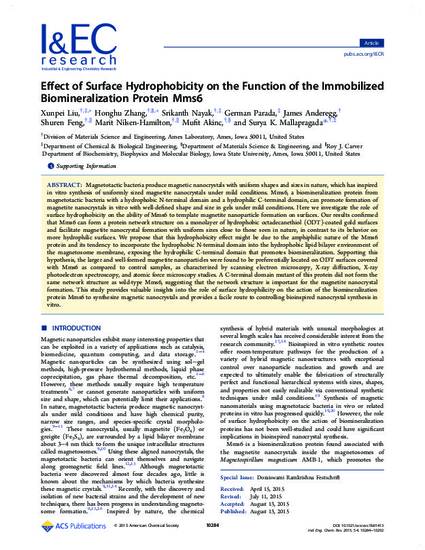
Magnetotactic bacteria produce magnetic nanocrystals with uniform shapes and sizes in nature, which has inspired in vitro synthesis of uniformly sized magnetite nanocrystals under mild conditions. Mms6, a biomineralization protein from magnetotactic bacteria with a hydrophobic N-terminal domain and a hydrophilic C-terminal domain, can promote formation of magnetite nanocrystals in vitro with well-defined shape and size in gels under mild conditions. Here we investigate the role of surface hydrophobicity on the ability of Mms6 to template magnetite nanoparticle formation on surfaces. Our results confirmed that Mms6 can form a protein network structure on a monolayer of hydrophobic octadecanethiol (ODT)-coated gold surfaces and facilitate magnetite nanocrystal formation with uniform sizes close to those seen in nature, in contrast to its behavior on more hydrophilic surfaces. We propose that this hydrophobicity effect might be due to the amphiphilic nature of the Mms6 protein and its tendency to incorporate the hydrophobic N-terminal domain into the hydrophobic lipid bilayer environment of the magnetosome membrane, exposing the hydrophilic C-terminal domain that promotes biomineralization. Supporting this hypothesis, the larger and well-formed magnetite nanoparticles were found to be preferentially located on ODT surfaces covered with Mms6 as compared to control samples, as characterized by scanning electron microscopy, X-ray diffraction, X-ray photoelectron spectroscopy, and atomic force microscopy studies. A C-terminal domain mutant of this protein did not form the same network structure as wild-type Mms6, suggesting that the network structure is important for the magnetite nanocrystal formation. This study provides valuable insights into the role of surface hydrophilicity on the action of the biomineralization protein Mms6 to synthesize magnetic nanocrystals and provides a facile route to controlling bioinspired nanocrystal synthesis in vitro.
Available at: http://works.bepress.com/mallapragada_surya_k/36/

Reprinted (adapted) with permission from Ind. Eng. Chem. Res., 2015, 54 (42), pp 10284–10292, doi:10.1021/acs.iecr.5b01413 Copyright 2015 American Chemical Society.